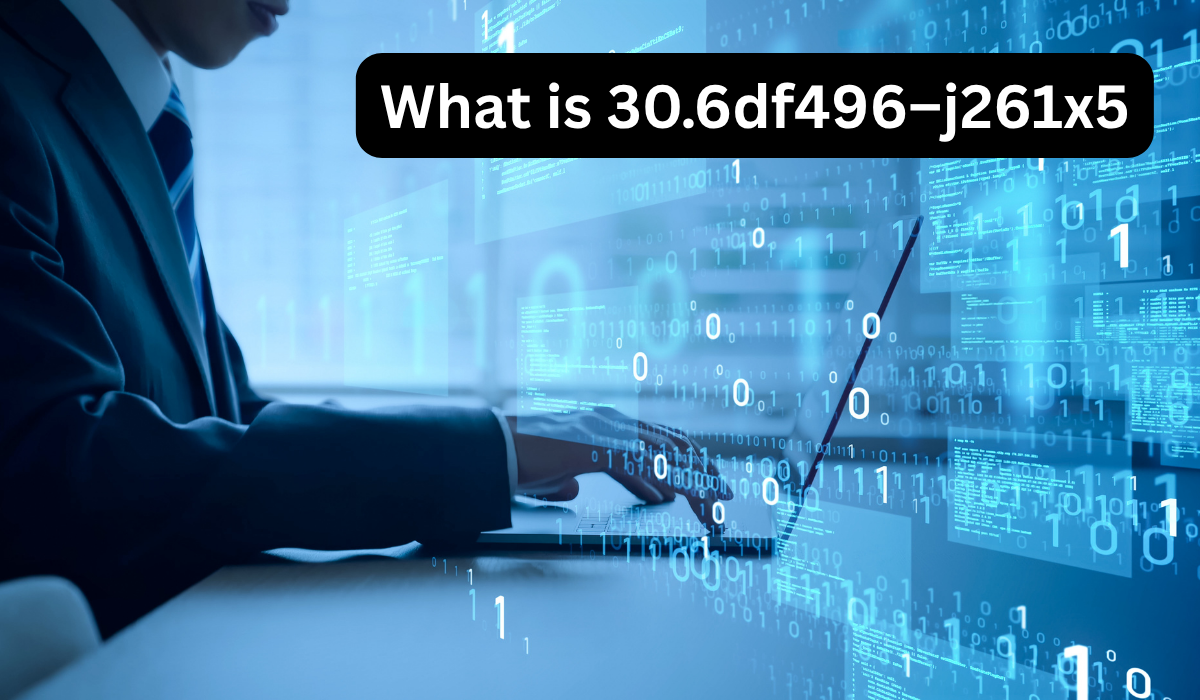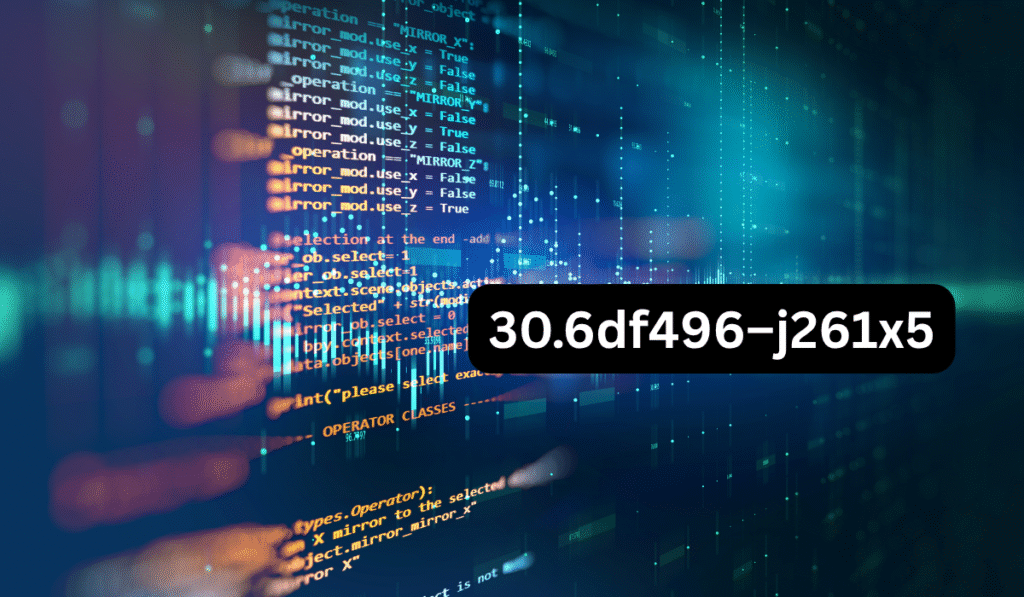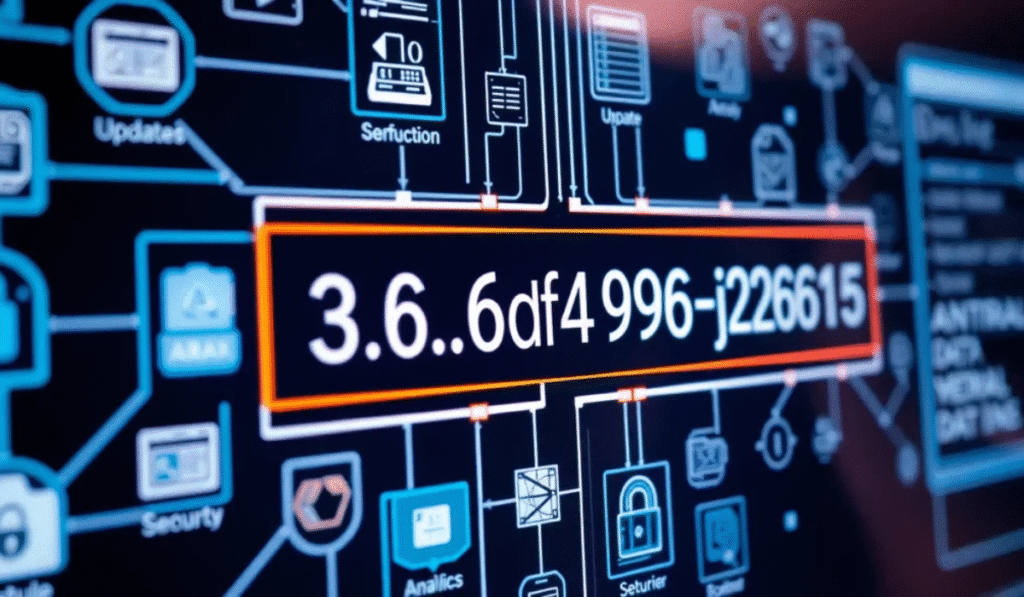
What is 30.6df496–j261x5: Your Complete Guide to This Enigmatic Identifier
With a continuously evolving digital space, there are identifiers or codes everywhere. Some are easy, and some seem impossible to decipher. A good example of this is 30.6df496–j261x5. So What is 30.6df496–j261x5, and why does it matter? In this article, we will look at the possible meaning of 30.6df496-j261x5, its structure, possible applications, and relevance in the current technology landscape.
What is 30.6df496–j261x5?
What is 30.6df496–j261x5? To answer that question simply, 30.6df496 – j261x5 is a structured alphanumeric identifier. This is not a random string – it is possible for each section of 30.6df496 – j261x5 to mean something, such as a version, product, dataset, or key to a system. Identifiers like these are found in software, databases, inventory management systems, and security systems.
While it is impossible to know where this specific identifier comes from, it seems that it follows a logical structure commonly employed by identifiers generated and implemented by a computer system. This identifier can be thought of as a digital fingerprint of something distinct.
What are Identifiers Like What is 30.6df496–j261x5?
When dealing with complex systems, each object, version, or thing requires a label. Instead of using names that might occur again, systems use codes like 30.6df496–j261x5 to denote uniqueness, consistency, and clarity.
Here is the rationale why codes are more preferable:
- Machine-readable and lightweight.
- They reduce duplicate and errors.
- They scale up easily as systems tend to expand.
- They can be generated and validated in a secure manner.
So, when asking what is 30.6df496–j261x5, we can likely conclude it is a system-generated identifier tied to the unique management or reference of digital stuff.
Decoding What is 30.6df496–j261x5
Let’s breakdown the above code as a further illustration of what is occurring:
- 30: This may be a version number or prefix denoting similar items.
- 6df496: This may be a hex-based identifier or part of a hashing function.
- j261x5: This may reference a user session, submodule, or component ID.
Each subdivision may have a localized meaning in the system in which it resides. It is important to observe that the inclusion of numbers, letters, and hyphen indicates a bitmap format. The lack of structure will be problematic when systems are sorting, processing, or retrieving related information.
Uses of 30.6df496–j261x5-Like Identifiers

Now that we have a clearer sense of 30.6df496–j261x5, let’s turn our attention to where such codes are generally found.
1. Software Development and Versioning
In the case of software development, an identifier like this is used for version updates, feature releases, and code changes. Developers will create similar strings as part of the build, commit, or deployment package to track changes. The attempt to prevent conflicts during the development of production-level use software is the need for a modified form of 30.6df496–j261x5. When similar versions are pulled and pushed into shared development environments, identifiers assist with version control and ultimately improve collaboration.
2. Data Management Systems
Data management systems rely heavily on unique identifiers like the code 30.6df496–j261x5. In data systems, there are usually some unique identifiers that help with labeling specific versions of datasets. For instance, the identifier can be used to reference the table version that allows you to keep track of data changes or multiple versions or to pull back precise information.
3. Inventory and Logistics
In supply chain management systems, similar codes tag products, shipments, or batches. Instead of writing “Box A from Factory 2”, one could use an identifier like 30.6df496–j261x5 as a universal identifier aiding with tracking efforts, to improve itemized-related inventory accuracy.
4. User Sessions and Authentication
In digital security, complex strings that are similar to 30.6df496–j261x5 are utilized to manage things like user sessions, authentication tokens, or API keys. Secure identifiers are intended to be unique and non-guessable, which provides meaningful security improvements for authentication systems and online services.
Advantages of Employing Identifiers such as 30.6df496–j261x5
Uniqueness
As seen with identifiers like 30.6df496–j261x5, these can be unique and there can be no confusion in systems declaring millions of entries, making every identifier original.
Privacy
Randomized identifiers help provide authenticated privacy from unauthorized access.
Machine-Friendly
Identifiers like 30.6df496–j261x5 are machine-friendly; easy to generate, store, decode, and process. You can easily automate systems to make sense out of them.
Scalable
Because identifiers like 30.6df496–j261x5 are structured, a company can move from dealing with hundreds of items to millions, and simply scale operations while having a system that will not break.
Problems with Complex Identifiers
While identifiers like 30.6df496–j261x5 have got a lot going for them, they are not without issues:
- Not Readable: Such codes are not easily read or memorized by humans.
- Need Documentation: Without context or definitions of structure, it can be difficult to know how to interpret the code.
- Typo Chance: Manually typing such identifiers is a risky proposal.
In an effort to reduce these issues, many organizations couple the use of these identifiers with scannable mechanisms, such as QR codes or barcodes.
Applications of 30.6df496–j261x5

30.6df496–j261x5 Multi-task learning is applied in many domains. Adaptable – its relevance is enriched as the current state of digital demands.
Use Cases in Industry
- Software Development – As developers we are using codes such as What is 30.6df496–j261x5 in version control for correctly tracking every update or change in the project.
- Finance – It assists with the recognition of encrypted data and safeguards sensitive transactions.
- Telecommunications – Data is compressed to make transmission more efficient.
- Stock Maintenance – Businesses use these identifiers to maintain stock and contribute them to a specific category.
Benefits for End Users
For your end-users, What is 30.6df496–j261x5:
- Faster access to systems
- Streamlined workflows
- Improved usability of interfaces
- Reliable and secure digital experiences
Breaking Down the Structure of 30.6df496–j261x5
In order to really understand what is 30.6df496–j261x5, we need to look under the hood:
- 30 → Could be a version, batch or numeric ID.
- 6df496→ Behaves much like a hash or cryptographic fragment value, to make it unique.
- j261x5 → Typical of a session or transaction id, alpha-numeric is always more complex.
This hierarchy provides uniqueness, unpredictability, and security.
Why Sequences Like 30.6df496–j261x5 Are Important
Identifiers such as 30.6df496–j261x5 are necessary to:
- Accuracy – Elimination of mismatches in files, updates or transactions.
- Traceability – The capability for the developers and support teams to be trace all activities.
- Cybersecurity – Increasing the difficulty of malicious actors to create or manipulate data.
Systems would encounter errors, lack of clarity or attacks if those indicators were not in place.
How 30.6df496–j261x5 Captures the Progress of Technology
The evolution of technology is demonstrated by the existence of codes such as 30.6df496–j261x5:
- Early computer programming languages only used simple numeric codes.
- As networks and cyber threats grew, more robust identifiers were required.
- They don’t anymore, we generally use standard alphanumeric codes for being flexible and unique enough to use.
- They are the tension between machine efficiency and human legibility, complexity and practicality.
How Are These Identifiers Generated?
Identifiers such as What is 30.6df496–j261x5 can be generated in various ways, depending on the intended use of the identifier:
- Random Generators: Unique codes are generated from random numbers and letters.
- Hash Functions: Fixed-length identifiers are generated from a value that has been encrypted.
- Custom Logic: Organizations develop custom formats for IDs based on internal structure and rules.
Regardless of how they are generated, the goal always remains the same; create a unique and traceable tag for something unique in a system.
The future of identifier systems
As technology becomes more interconnected, the number of identifiers such as 30.6df496–j261x5 will continue to proliferate. So what will be the future identifiers look like?
- They will be smarter and will have more hidden data inside of them.
- They will be safer and less likely to misuse.
- They will interact with artificial intelligence in order to auto-track and auto-interpret.
- They will be agnostic across platforms and systems through standardization.
The next version of identifier systems will likely be a blended human-readable name that includes a cognizable machine structure.
Conclusion
So, what is 30.6df496–j261x5? A unique, structured identifier that is intended to label, organize, and secure data, processes, or systems. 30.6df496–j261x5 may be a dataset, software version, product batch, or user session-but this will depend on the contextual information that surrounds it.
In few words, identifier systems, (even if they seem randomly generated), are important to the function of modern systems, in which we, as humans, rely on their precision, scalability, and efficiency be in software development, managing inventories, or ensuring digital security.
We understand more about how identifiers are actual images of the world that are relevant to how we interact with technologies in order to begin to understand the invisible structure of the world in which we live. The next time you see a code like this, you will know that underneath is a powerful system that is working invisibly.
Read More: Custom Mobile App Design by Garage2Global || Doctorhub360.com


